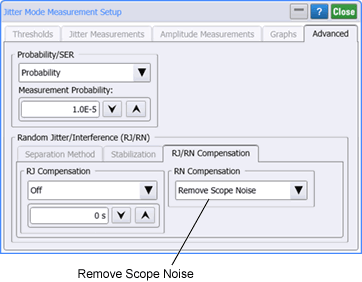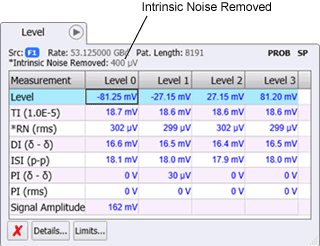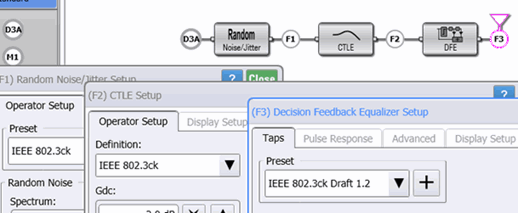Noise Processing in Jitter Mode
FlexDCA’s Jitter Mode analysis works by acquiring targeted samples to characterize the various components of jitter, noise, and interference as quickly as possible. When analyzing noise, jitter mode works by finding a region of the signal that has the correct symbol level yet minimal slope. A large number of samples are taken in this region and then spectral and/or statistical techniques are used to characterize the noise. Filters and other signal processing operations are applied to the power spectral density function of the noise in order to determine the correct magnitude of the noise and interference components after processing.
Intrinsic Noise Removal
FlexDCA allows automatic compensation of the channel’s intrinsic noise. Every time a DCA channel is calibrated the user is required to disconnect all signals from the channel. When this is done, FlexDCA measures and stores the amount of channel noise for each channel bandwidth/filter. This noise can then be removed from the measurements so that only the signal noise is reported. To enable intrinsic noise removal, select the appropriate RN Compensation value from the Advanced tab of the Jitter Mode Measurement Setup dialog, as shown in the following figure. When this feature is active, the amount of intrinsic noise that is being removed is reported in the measurement results area. Note that if the intrinsic noise is large compared to the signal noise, the accuracy of the measured noise will be reduced. Also note that the value of intrinsic noise reported is the value after applying the signal processing operations. By way of example, if a channel has 1 mV of intrinsic noise but an Amplify signal processing operator is used with a scale factor of 2.0, then the amount of intrinsic noise that will be removed is 2 mV.


Because the noise is measured during calibration, it is important that signals be fully disconnected from the channel during calibration. Some sources may continue to inject noise or offsets even when their outputs are nominally disabled. This may increase the amount of noise measured during calibration and thereby cause FlexDCA to remove more noise than is actually intrinsic to the channel.
Reference Receivers with Noise
Some standards, such as IEEE 802.3ck, call out a reference receiver with a specific frequency response and a specific amount of noise. This can be achieved in Jitter Mode using the Random Noise signal processing operator along with the Remove Intrinsic Noise feature described above. These two features will work together such that just the right amount of noise is added or removed to attain the noise indicated in the configuration of the Random Noise operator. A typical configuration for 802.3ck is shown in the following figure. The input to this chain should be a differential electrical channel with SIRC enabled and set to a 4th order Butterworth response with 39.84 GHz bandwidth. Electrical SIRC, the Random Noise operator, CTLE, and DFE all have presets to select the correct configuration for the standard. When combined with the “Remove Scope Noise” feature the precise amount of noise can be included in the measurement analysis to comply with the standard. Note that there is also a setup file in the \Demo folder that has the correct setup for IEEE 802.3ck Eye Opening measurements using an N1060A module.
C:\Program Files\Keysight\FlexDCA\Demo\Setups\Demo\IEEE\IEEE_802.3ck_Eye_Opening_N1060A_N1000A.setx

For this case of a reference receiver with defined noise, FlexDCA may need to add noise or it may need to remove noise, but it will not do both. If the intrinsic noise of the instrument exceeds the desired amount of noise specified by the Random Noise operator, then the Random Noise operator will not add any noise and instead the correct fraction of the intrinsic noise will be removed such that the desired reference noise is obtained. On the other hand, if the noise specified by the Random Noise operator exceeds the intrinsic noise, then the Random Noise operator will only add enough noise to bring the total up to the desired value. This is indicated by the “Intrinsic Noise Remove” value shown in the Level results panel that is shown in the figure Jitter mode allows removal of intrinsic noise above. If the desired noise exceeds the intrinsic noise, then the value of noise removed will be indicated as zero. On the other hand, if the intrinsic noise exceeds the desired noise then the amount of noise actually removed will be indicated.